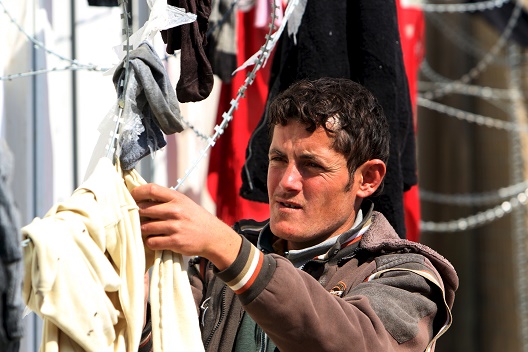 Talks about retaking Mosul from the Islamic State (ISIS)—a city of 1 million people—are once again in the news. But Iraqi and US military planners need to think creatively about how best to minimize civilian harm in what is anticipated to be a long and fierce urban campaign where ISIS fighters are likely to be using civilians as human shields.
Talks about retaking Mosul from the Islamic State (ISIS)—a city of 1 million people—are once again in the news. But Iraqi and US military planners need to think creatively about how best to minimize civilian harm in what is anticipated to be a long and fierce urban campaign where ISIS fighters are likely to be using civilians as human shields.
Urban warfare is fraught with danger, as several residents of Ramadi now displaced in Erbil recounted to me. Ahmed—a diabetic with an amputated leg and 5 children, who lived in the markaz (city center)—described how he and other families (around 160 people) were used as human shields and forced to move under threat of death. “When you are threatened with a grenade and execution of your children, what do you do?” he said. “We had to move when Daesh [acronym for ISIS in Arabic] told us to.” In December 2015, as Iraqi forces approached the city, “Daesh relied on us to protect them.”
Abdul, whose family was also among the 160 families forced to move with ISIS several times explained, “We wanted to leave Ramadi, but Daesh threatened, ‘we will blow up your house with you and your family.’ We could not refuse.” He angrily described what it was like to be human shields for ISIS, “We lived in constant fear that as human shields either the ceiling would collapse with coalition airstrikes or we would die by shelling of Daesh or by the IEDs laid on the roads toward the frontlines. There was danger all around,” said Abdul.
One such family who was also forcibly moved with ISIS described how his two cousins died from air strikes. Ramsi explained that in December 2015, “Daesh fired at the jet fighters in front of the houses where we were. They came back and fired at Daesh. My two cousins were outside and died. Now I know what it means to be a human shield.”
Many of the families had been forcibly moved twice and were last in Sofia when on January 9 and 10 they decided to risk ISIS fire running towards the front line, some waving white flags. Many died or were injured in the attempt.
Hind, 28, was the victim of an IED as she, her husband, and two sons ran towards the frontline on January 10. The IED blew up 500 meters from where the Iraqi forces were. Shrapnel hit Hind and her two sons (9 and 12 years-old each) on their legs and arms, Hind suffered the most, losing one leg and suffering severe injuries to the other. The paramedic at the Habbaniya base amputated left leg. Yet, Hind and her family are the lucky ones who survived—the other family of four (two girls and two women) travelling with them lost their mother who died on the spot.
These are just some of the many stories of survival among the civilians who have fled the fighting between ISIS and government forces. Their journey like others is full of peril. Civilians are trying to escape but ISIS prevents them from leaving. Some in the recent past have paid large fines to ISIS to leave. Others face dangers from ISIS shelling or IEDs that are mined in the outskirts of cities like Mosul.
“Many who are under ISIS rule have spent all their savings and can’t pay a fine to leave. They don’t have options except to pray that they are not killed in the operations to retake Mosul,” said Mohsin a former resident of Mosul city. Three frontline Peshmerga commanders in the Kirkuk governorate also explained that, since November 2015, they have seen a decline in persons trying to secretly cross from ISIS territory to the Kurdistan Region of Iraq, “Daesh has killed those who tried to leave as warning to others.”
The difficulties civilians face leaving ISIS areas makes planning to retake Mosul a challenge, both in terms evacuating populations and fighting in densely populated areas. Humanitarian experts and military planners are discussing humanitarian corridors and guiding persons to safety, but there is concern that many could die fleeing the fight from IEDs or shelling.
Tactically, the hope is that many civilians in Mosul will rise up against ISIS. Atheel al-Nujafi, a former governor of Nineveh Province, explained that residents who welcomed ISIS initially as a bulwark to mistreatment by Shia-dominated security forces in Mosul no longer support ISIS. “A majority will rise up to fight if they are assured of their safety by the Iraqi government.” The use of the Shia Hashd Shabi (Popular Mobilization Units) in the Mosul operations, he explained, would be counterproductive as it would strengthen the ISIS narrative as savior of Sunnis. Thus, any victory against ISIS will be temporary if government forces backed by the coalition are not prepared to protect civilians living under ISIS rule. “Mosul must be retaken by an alliance that is acceptable to Sunnis,” added al-Nujafi.
The toll on civilians in the fight against ISIS cannot be underestimated and must be at the forefront of any planning to retake Mosul. As Abdul, whose family was used as a human shield expressed, “Government forces are on one side, coalition is in the air, and Daesh on the other. We civilians are in the middle.”
Sahr Muhammedally is the Senior Program Manager for MENA and South Asia at Center for Civilians in Conflict
Image: Sunni Muslim who had fled the Islamic State's strongholds arrives at a refugee centre in Makhmour, south of Mosul, Iraq, March 13, 2016. (Reuters)

